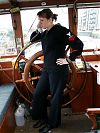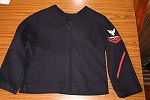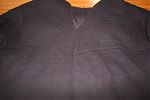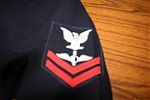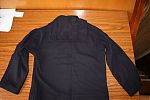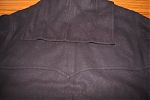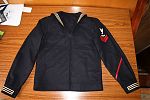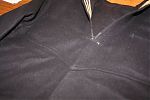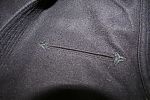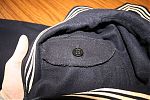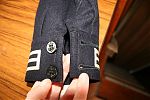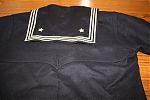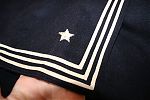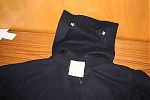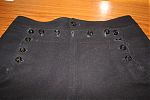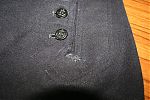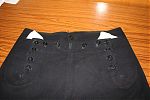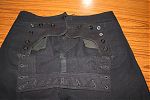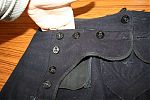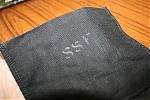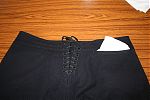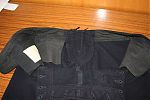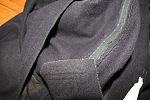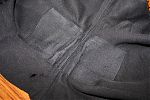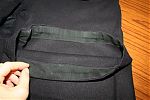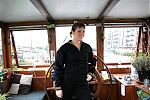I realise I’m an entire week late for Veterans Day and Remembrance Day here, but I thought that my dad’s vintage 1960s Navy uniform would still be just as interesting today.
Here’s my dad leaving Boot Camp in 1960:

(Compare that to his Santa-look these days – he blames it on all the beer and bratwurst when he was stationed in Germany!)
My dad was cleaning out his closet and thought I might like his old uniforms, so he dry cleaned them up and sent over the navy wool dress uniform first (the whites are coming later!). Much to my surprise, his old uniform fit me exactly – it was almost eerie, I tell you! Apart from the arms being an inch or so too long in the cuffed-sleeve top, it’s like it was made precisely to my measurements. And apart from one worn hole in the trousers, they absolutely look like new…
I suppose we’ve got boats in the blood in my family – my dad was in the Navy, my brother works for the Navy, and I’m lucky enough to live on a boat with a photogenic wheelhouse to pose in!
I took a bunch of detail photos of various parts of the uniform, because I found them to be extremely well sewn and I was really surprised at the level of detail that went into these uniforms, especially when you consider the sheer number of these which were made. I’m sure my dad can fill us in further in what the two different tops were worn for, as one is much more detailed than the other. But first we’ll look at the less-detailed top, with the straight sleeves and plain collar…
Navy top 1:
I just love the curved yoke seam on the front and back – it almost reminds me of Western wear… And as I said, the collar on this first top is just the plain navy blue wool, with no braid or embroidery. Underneath the collars on each of the shirts is a tag that must’ve given a sailor’s number, name, and rank so they knew which one was theirs when it came back from the laundry, but these have since faded to nothing, I’m afraid.
This second top was much more richly decorated and I’m guessing was used with more formal ceremonies, in conjunction with a white hat and navy tie (as you can see in my Dad’s photo above) which have since been lost (unlike the peacoat, which was abandoned in Taiwain, much to my dad’s regret and my horror!).
Navy top 2:
This one also has that great curved yoke, front and back…
The photo on the left is the outside chest pocket, with the beautiful welts and embroidered diamond ends (somehow I doubt the uniforms today have that!). The photo on the right is the interior chest pocket on the opposite side, which is clearly much more secure…
Apart from the beautiful work on the sleeve placket and braiding, how much do you love that all the buttons have anchors on them?!?
And here’s the collar, with its sewn-on braid and embroidered stars! You can see the underside in the last photo, with that faded ID tag I was talking about earlier, too.
Finally, the stereotypical sailor trousers! These are huge on the catwalks these days and there are quite a few patterns out there that replicate the button placket front, so I thought that detailed photos of an original pair might be helpful for those of you sewing your own.
Navy trousers:
Here’s the placket with all the buttons closed (yup, the central button got lost somewhere down the line!). I love the decorative reinforcement at the stress point, and the last photo shows the placement of two hidden pockets! Can you believe I wore these all night before I actually discovered they were there? They fit just behind the button closuree and are about the same interior size as jeans pockets today.
And here’s some photos of the placket unbuttoned, so you can see all the seam binding and facings. You can also see the size of those hidden pockets, and to my surprise, I found my dad’s initials stencilled on the interior underside of one of the pockets, too!
At the back waist, there’s a gusset with a bunch of lacing to tighten or loosen the fit of these trousers, too. You can see the inside of the lacing in the second photo, where they’ve attached a triangular facing so you don’t show any skin!
I was struck not only by the decorative touches put into these uniforms, but also the practical ones – the seams are all taped (what we’d call a “Hong Kong finish”), the crotch area is completely reinforced (though you can just see the wear hole in that middle photo, just outside the reinforcement!), and the hems are reinforced in the inside with what looks like grosgrain ribbon (the hems of the shirts are similarly reinforced).
So, even though I’m a week late, I think we should appreciate our veterans more often than one day a year anyway. So if you’ve enjoyed these photos of my dad’s uniform, please make a point to thank a veteran today (no matter when you’re reading this).
Edit: I got more information from my dad regarding the uniform!
What a surprise! You look great in Navy Blue. Too bad I didn’t have a black silk neckerchief to finish off the “Dress” blues. Oh, and you need a brand new white T-shirt to be “in uniform.” The DRESS blues [2nd top -mf] were always worn for inspections, parades, winter travel and other formal occasions. The “Undress” blues [1st top -mf] were more comfortable, lacked the white piping that required frequent toothbrushing with Wisk to keep clean. No neckerchief is worn with the undress jumper, nor are any ribbons or medals, which are reserved for special occasions only with dress blues (or dress whites). obtw, black socks are worn with black shoes with both blues and the whites. Ditto for the “white hat” dixie cups.
The Whites [were shipped and just arrived -mf]. Without the neckerchief, a dress white jumper converts to an undress jumper – there’s no piping involved with the whites. If one had dirty duty, you wore a light blue chambray shirt and a type of bellbottom blue jeans with “boondockers,” a low black boot. Otherwise, my usual office work atmosphere had me wearing undress blues and whites in warmer weather. Sorry, none of the comfortable, physical labor chambray/blue jeans survived.
Thirteen Buttons. Many sailors were often “out of uniform” by failing to have all 13 buttons buttoned all the time. The visible side buttons were always buttoned, but to save time to micturate, hitting the head for a bit of quick relief, the top buttons (covered by the jumper) were left undone. This conveniently reduces the risk of losing and re-sewing loose buttons.
If you’re interested in reading more about his experiences in the Navy, my dad wrote a book titled “Letters to Mom”, and you can read excerpts from it here, though he says he wants to clean up the coding over Christmas now that I’ve prodded him!



